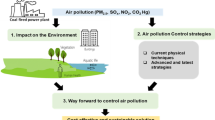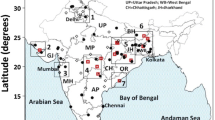Abstract
Selective catalytic reduction (SCR) is an emissions control technique that primarily reduces harmful emissions of oxides of nitrogen (NO x ). To maintain SCR performance, catalyst layers maybe added, removed, or replaced to improve NO x reduction efficiency. To make these changes, power plants must be temporarily shut down, and SCR maintenance during scheduled power plant outages can be very expensive. Consequently, developing a fleet-wide SCR management plans that are both efficient at reducing NO x and limiting operating costs would be extremely desirable. We propose an SCR management framework that finds an optimal SCR management plan that minimizes NO x emissions using integer programming. The SCR management tool consists of two main modules—the SCR schedule generation module and the SCR optimization module. Furthermore, the SCR management framework addresses decision making from the fleet-wide perspective as well as a single plant as opposed to only a single plant, which is currently commercially available. We demonstrate the effectiveness of the tool and provide a tradeoff between NO x reduction and operating cost using Pareto optimal efficient frontiers.
Similar content being viewed by others
References
Chen, J., Frey, H.: Optimization under variability and uncertainty: A case study for NO x emissions control for a gasification system. Environ. Sci. Technol. 38, 6741–6747 (2004)
Cichanowicz, J., Muzio, L.: Factors affecting selection of a catalyst management strategy. In: Proceedings of the DOE-EPRI-EPA-AWMA Power Plant Air Pollutant Control Mega Symposium: DOE/EPRI/EPA/AWMA, Washington, DC (2003)
Cichanowicz, J., Smith, L., Muzio, L.: Twenty-five years of SCR evolution: Implications for U.S. application and operation. In: Proceedings of the EPRI-DOE-EPA Combined Power Plant Air Pollutant Control Symposium: The MEGA Symposium; EPRI/DOE/EPA, Chicago, IL (2001)
Cichanowicz, J., Smith, L., Muzio, L., Marchetti, J.: 100 gw of SCR: Installation status and implications of operating performance on compliance strategies. In: Proceedings of the EPA-EPRI-NETLAWMA Combined Power Plant Air Pollutant Control Mega Symposium: EPA/EPRI/NETL/AWMA, Washington, DC (2003)
COIN-OR Branch-and-Cut MIP Solver. https://projects.coin-or.org/Cbc
Diwekar, U., Rubin, E., Frey, H.: Optimal design of advanced power systems under uncertainty. Energy Convers. Manag. 38(15), 1725–1735 (1997)
FERCo: CatReact software. http://www.ferco.com/catreact.html
Frey, H.: Engineering-economic evaluation of SCR NO x control systems for coal-fired power plants. In: Proceedings of the American Power Conference, Chicago, Illinois (1995)
Grabitech: MultiSimplex software. http://www.grabitech.com/Multisimplex.htm
Mi, J.: CFD for SCR design. Tech. rep., Southern Company Inc.
Muzio, L., Quartucy, G., Cichanowicz, J.: Overview of status of post-combustion NOx control: SNCR, SCR, and hybrid technologies. Int. J. Environ. Pollut. 17(1–2), 4–30 (2002)
Nemhauser, G., Wolsey, L.: Integer and Combinatorial Optimization. Wiley-Interscience, New York (1999)
Padberg, M., Rinaldi, G.: A branch-and-cut algorithm for the resolution of large-scale symmetric traveling salesman problems. SIAM Rev. 33(1), 60–100 (1991)
Pritchard, S., DiFrancesco, C.: SCR catalyst management: Enhancing operational flexibility. Tech. rep., Cormetech, Inc. (2006)
Pritchard, S., DiFrancesco, C., Kaneko, S., Kobayashi, N., Suyrgama, K., Eda, K.: Optimizing SCR catalyst design and performance for coal-fired boilers. In: Proceedings of the EPRI/EPA 1995 Joint Symposium on Stationary Combustion NO Control, Kansas City, MO (1995)
Rogers, K., Milobowski, M., Wooldridge, B.: Perspectives on ammonia injection and gaseous static mixing in SCR retrofit applications. In: Proceedings of the EPRI-DOE-EPA Combined Utility Air Pollutant Control Symposium, Atlanta, Georgia (1999)
Rubin, E., Salmento, J., Frey, H.: Cost-effective emission controls for coal-fired power plants. Chem. Eng. Commun. 74, 155–167 (1988)
Rubin, E., Kalagnanam, J., Frey, H., Berkenpas, M.: Integrated environmental control concepts for coal-fired power plants. J. Air Waste Manag. Assoc. 47(11), 1180–1188 (1997)
Staudt, J., Engelmeyer, A.: SCR catalyst management strategies-modeling and experience. In: Proceedings of the DOE-EPRI-EPA-AWMA Power Plant Air Pollutant Control Mega Symposium: DOE/EPRI/EPA/AWMA, Washington, DC (2003)
Tennessee Valley Authority: Coal-fired power plant. http://www.tva.gov/power/coalart.htm
The U.S. Department of Energy and Southern Company Services, Inc.: Topical report number 9, control of nitrogen oxide emissions: Selective catalyst reduction (SCR). http://www.netl.doe.gov/technologies/coalpower/cctc/topicalreports/pdfs/topical9.pdf (1997)
Author information
Authors and Affiliations
Corresponding author
Additional information
Patent pending.
Rights and permissions
About this article
Cite this article
Phananiramai, P., Rosenberger, J.M., Chen, V.C.P. et al. A mathematical optimization technique for managing selective catalytic reduction for coal-fired power plants. Energy Syst 2, 171–188 (2011). https://doi.org/10.1007/s12667-011-0030-0
Received:
Accepted:
Published:
Issue Date:
DOI: https://doi.org/10.1007/s12667-011-0030-0




